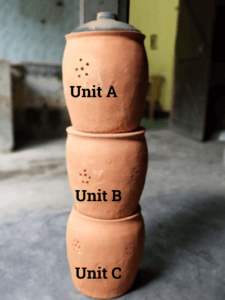Urban Home Composting
For urban home composting, there needs a three-unit composter where all the kitchen/organic waste will be composted. The Composter will be made of clay. To understand easily, the units are named A, B and C here. A and B units are identical clay pots with a big hole at the bottom and some mini holes on the wall for proper air circulation. There is no hole at the bottom of the C unit and it is the main composting unit. The steps of home composting in urban households using the composter are given below-
Step-1: Selection of Place
- The composter must be put in a convenient place on the balcony or terrace.
- The place should be safe from rain and pets.
Step-2: Start Throwing Kitchen Waste
- At first, the hole at the bottom of the A unit needs to cover with paper.
- Then coat 3/4 handful of dry leaves/ashes/coco peat on it.
- Put your kitchen waste on the coco peat layer.
- Again coat 3/4 handful of dry leaves/ashes/coco peat on it.
- Cover the waste with paper and then cover the whole pot with a lid.
- The next day, remove the paper cover and throw the kitchen waste on it like the previous way and cover it up again.
Step-3: Daily Routine
- Put your kitchen waste daily in the A unit using the same process until it fills up 3/4 portion.
- Stire the waste in some time until it occupies 3/4 of the container.
- When the A unit gets 3/4 filled up, replace it with the B unit and start to fill the container with waste in the same way as before.
- B unit also needs to be filled 3/4 of the container.
Step-4: Continuation of the Unit Replacement Process
- When the 3/4 portion of the B unit gets filled up by wastes, transfer the waste of unit A to the C unit.
- Then put the A unit on the top again and repeatedly follow the whole process by rotation.
Step-5: Collection
- Within one and half months, waste in the C unit will be turned into compost fertilizer.
- When the compost of the C unit turns dark brown or black, it is ready to use as fertilizer.
- For good fertilizer, it must be strained first. Put the coarse particles in the top unit again for composting.
- The presence of white mold in it is an indication of good compost.





